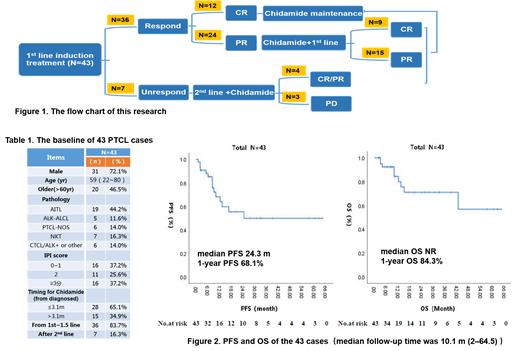Abstract
Background
Peripheral T-cell lymphoma (PTCL) is a set of rare and heterogeneous clinically aggressive mature T- and natural killer cell neoplasms, all of which are associated with poor prognosis. PTCL treatments are usually associated with a high failure rate and frequent relapses. To improve the poor clinical outcomes of PTCL, novel agents that target various pathways have been intensively studied and developed. Histone deacetylase (HDAC) inhibitors are among the most significant improvements made in recent years. Chidamide, a novel benzamide class of HDAC inhibitor, showed significant efficacy in relapsed/refractory PTCL patients in previous studies. In China, a high percentage of PTCL patients are elderly and not suitable for transplantation, and many patients cannot afford transplantation. There is an urgent medical need for maintenance therapy for PTCL patients, and chidamide single-agent maintenance therapy may benefit PTCL patients ineligible for autologous stem cell transplantation (ASCT) with its proven outstanding antitumor effects.
Methods
In this prospective, single-center, single-arm study, a total of 43 patients with PTCL, including angioimmunoblastic T-cell lymphoma (AITL) (44.2%), anaplastic large-cell lymphoma, ALK − (ALCL, ALK −) (11.6%), PTCL-not otherwise specified (PTCL-NOS) (14.0%), extranodal NK/T-cell lymphoma (NKT) (16.3%), and other PTCL subtypes (14.0%), were enrolled from January 2016 to March of 2021. All patients were ineligible for transplantation. They had a median age of 59 years (22-80). Thirty-six patients (83.7%) received chidamide maintenance after induction treatment, and 7 patients (16.3%) started chidamide maintenance treatment after salvage treatment. Endpoints included progress-free survival (PFS), overall survival (OS), and safety assessment.
Results
Until April 2021, the median follow-up time was 10.1 months (2-64.5). The complete remission rate (CR) was 44.2% and overall response rate (ORR) was 79.1%. The median PFS was 24.3 m, and the 1-year PFS rate was 68.1%. The median OS has not yet been reached, and 1-year OS rate was 84.3%. Stratified analyses of PFS and OS showed no significant differences. Grade 3/4 adverse events were mainly hematological toxicities, including neutropenia, leukopenia, thrombocytopenia, and anemia, and they were well tolerated.
When used a first-line/1.5-line treatment, i.e., for patients who had achieved CR after introduction treatment (12 cases) or who did not achieve CR but received chidamide + chemotherapy consolidation treatment (24 cases), chidamide maintenance therapy was found to maintain the effect of CR (in all 12 patients) or improve the clinical outcomes to CR/PR (partial remission) (9 out of the 24 patients). Even when used after salvage treatment, chidamide maintenance was found to achieve PR and better efficacy in 4 out the 7 patients.
Conclusions
Chidamide maintenance treatment achieved significantly high CR and ORR rates for PTCL patients. This therapy may improve PFS and OS with a manageable safety profile for PTCL patients. This treatment thus may benefit PTCL patients who are ineligible for or cannot afford ASCT, which is an especially severe problem in China. Further large-scale, multi-center, randomized studies are required to extensively examine the efficacy and safety of chidamide maintenance therapy in PTCL.
No relevant conflicts of interest to declare.


This feature is available to Subscribers Only
Sign In or Create an Account Close Modal